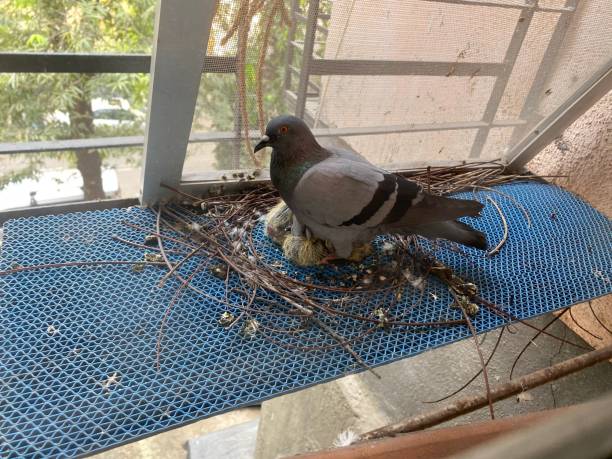Pigeons are cute, chubby birds you see all over the place. There are many kinds, like the Rock Pigeon and the Mourning Dove, and they live in cities and the countryside.
One special thing about pigeons is how they build their nests. They take turns sitting on the eggs and caring for their babies in the nest.
In this article, you will learn all about pigeon nesting habits and behaviors. We will also explore the intricacies of their nesting sites, nest construction, and parental care.
Nesting sites and needs
Pigeons like to make their nests in many places. They can nest on cliffs and trees and on balconies and bridges in cities. Feral Pigeons, which come from wild Rock Doves, prefer buildings made by people. They need a dry and safe place with a flat surface for their nest.
You can often find their nests in attics, on roofs, ledges, eaves, and under bridges. In nature, they would nest on rocky cliffs or in caves. Pigeons like high, flat ledges because they feel safe and protected from other animals.
Nest construction and materials
A pigeon’s nest is incomplete until a male pigeon finds a mate. The male begins building the nest while calling out for a female. He sits at the nesting site, hoping to attract a mate, and often struts around, cooing at his favourite female.
If the female is interested, she will respond to him. Then, the male pigeon searches for materials to build the nest, like twigs, grass, and other plants. He gathers these and arranges them to make a neat and cosy nest.
The female pigeon will then join him, and together, they will add more materials to the nest, making it a comfortable and safe home for their young.
Parental care and incubation
Both parents contribute to nest construction and incubation. The female pigeon will lay two eggs, which will be incubated for about 17-19 days. Both parents will take turns sitting on the eggs, keeping them warm and safe.
After the eggs hatch, the young pigeons, called squabs, will rely on “Pigeon milk,” a protein and fat-rich fluid both parents produce. The parents will regurgitate this milk to feed their young, providing them with the necessary nutrients for growth and development.
Challenges in Urban Settings
Urban Pigeons, while a common sight, face threats from predators and human conflicts. They are seen as pests due to potential disease spread and fouling of structures. Effective management involves deterring Pigeons by limiting nesting sites and food sources.
This can be achieved through bird-repellent devices, such as visual deterrents and noise-making devices.
Also, regular cleaning and maintenance of buildings and structures can help reduce the attractiveness of these sites to Pigeons.
Pigeon nesting habits and behaviors
Have they ever wondered where and how urban pigeons build their nests? Join us as we explore the world of pigeon nesting, uncovering the habits and behaviours of these fascinating birds.
Pigeons are adaptable and can nest in various places, from natural spots like cliffs and trees to urban areas like balconies and bridges. Wild pigeons, descendants of Rock Doves, prefer structures made by humans.
Pigeons make simple nests and often use the same spot multiple times. Both parents help build the nest and take turns sitting on the eggs. The baby pigeons, called squabs, are fed “pigeon milk,” a nutrient-rich fluid both parents produce.
The chicks leave the nest after about 25-30 days and are fully grown and able to fly after about 35-40 days.
Conclusion
Pigeons are very adaptable birds, nesting in many places, from tropical rainforests to apartment balconies. The feral pigeon (Columba livia domestica) is now one of the most common birds in cities worldwide, thanks in part to its effective breeding habits.
By learning how pigeons nest and behave, we can better appreciate their adaptability and complexity. Whether in nature or in cities, pigeons have learned to thrive. Their unique nesting habits and behaviours show their incredible resilience and flexibility.
FAQs
Where do pigeons build their nests?
Pigeons build their nests in sheltered nooks and crannies on buildings, cliffs, or trees. They often choose locations that provide safety and protection for their eggs and young.
What materials do pigeons use to build their nests?
Pigeons construct their nests using interwoven twigs, grass, feathers, paper scraps, or other debris.
How many eggs do pigeons lay at a time?
Pigeons typically lay 1-2 white eggs that both parents incubate for about 18 days.
Do pigeons reuse their nests?
Yes, pigeons form long-term pairs and typically reuse their nests. If disturbed, the adult bird will usually leave the nest but return when it feels safe.
How do pigeons care for their young?
Both parents take turns sitting on the eggs and caring for their young, providing food and protection until the young pigeons are full-grown and ready to leave the nest.
Can pigeons nest in any month?
It is important not to disturb a bird’s nest until it has finished nesting. If you have to move a pigeon’s nest, try to move it to a similar nearby location. Use gloves when handling the nest and make the move as quick as possible to minimize stress for the birds.
Read More:














